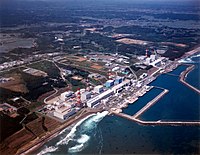
Photo from wikipedia
Abstract NUREG/CR-6850 provides a universal process to conduct fire Probabilistic Risk Analyses (PRAs) of Nuclear Power Plants (NPPs). A three-step procedure among the report’s findings is proposed for quantifying fire-induced… Click to show full abstract
Abstract NUREG/CR-6850 provides a universal process to conduct fire Probabilistic Risk Analyses (PRAs) of Nuclear Power Plants (NPPs). A three-step procedure among the report’s findings is proposed for quantifying fire-induced risks of potentially risk-significant fire scenarios: i ) Estimation of the compartment fire ignition frequencies associated with the fire ignition sources; ii ) Estimation of the frequency of occurrence of the compartment fire scenario; and iii ) Quantification of the fire PRA model induced by the fire scenario, to generate the fire risk results. The procedure supported by operational records of traditional Light-Water Reactors (LWRs) also can be applied to the new-type reactors, provided that the challenges of the new imbedded features and equipment can be legitimately tackled. In this study, three key issues manifested in the applications of the three-step fire risk quantification procedure to new-type reactors are discussed, namely, ignition frequency estimating approaches of the new-reactor-specific fire compartments in i ), applicability analysis of the fire modeling tools and uncertainty treatment in ii ), and updating fire PRA models in iii ). The feasibility of the analysis is illustrated to a switchgear room fire scenario of the first demonstration NPP of High Temperature Gas-Cooled Reactor (HTR-PM) in China.
Journal Title: Nuclear Engineering and Design
Year Published: 2018
Link to full text (if available)
Share on Social Media: Sign Up to like & get
recommendations!